Mulhacén 3478m is the highest mountain in mainland Spain and is situated in the Sierra Nevada mountains of southern Spain. The Sierra Nevada is also Spain’s largest national park making this a very special area. The name Mulhacén is taken from the name of the penultimate Arab king, “Muly Hacen” when this was the Kingdom of Al-Andalus. Legend has it that he is buried on the mountain!
This is an especially nice walk, not just because of its stunning mountain scenery, but also the Sierra Nevada is famous for its wildlife. Our aim with The Tour of Mulhacén is to combine the best aspects of the Sierra Nevada National and Natural Parks, that make them such a special place, into a week long hike. This includes ascents of the two highest mountains in the Sierra Nevada: Veleta 3396m and Mulhacén 3482m.
A unique journey through the Sierra Nevada mountains, with the mighty Mulhacén in view. We start in the south at the mountain village of Capileira, following the GR240 to Trevelez, then over a high mountain pass to the north of the range, with it’s rugged scenery and wonderful views of the high peaks. From here we traverse the northern slopes staying in mountain refuges before returning to the south side for a final ascent of the two highest mountains, Veleta and Mulhacén itself. A true mountain experience and we believe a worthy challenge to the popular Tour of Mont Blanc!
Mulhacén situated in The Sierra Nevada National Park near the city of Granada around two hours drive from Malaga. There are several long distance trails passing through or around the Sierra Nevada, but none that combine the villages, the highest peaks and pass through the different and varied climatic and wildlife zones in a way that can be enjoyed.
Itinerary:
Day 1
Capileira to Trevelez
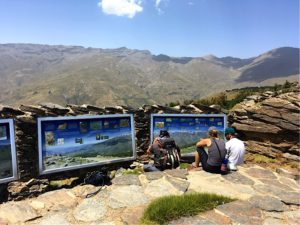 A route following the GR240 between the two highest villages in Andalucia. 6 to 7 hours walking with about 800m of ascent. However we take the National Park bus to the viewpoint of Puerto Molino 2400m where you will get your first glimpse of Mulhacen. From here the route is mostly downhill back to the GR240 and Trevelez.
A route following the GR240 between the two highest villages in Andalucia. 6 to 7 hours walking with about 800m of ascent. However we take the National Park bus to the viewpoint of Puerto Molino 2400m where you will get your first glimpse of Mulhacen. From here the route is mostly downhill back to the GR240 and Trevelez.
The section after leaving the forest road although signposted has a very remote feel and requires careful navigation. In its own right a superb day of hill walking!
Day 2
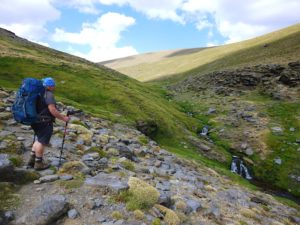 Trevelez to The Postero Alto Refuge
Trevelez to The Postero Alto Refuge
Ascending the Rio Trevelez to Puerto Trevelez before descending to the Postero Alto Refuge. About 9 to 10 hours walking with 1500m of ascent. The hardest day on The Tour!
From Trevelez we follow the pleasant Rio Trevelez until the steep ascent of El Horcajo. With Horcajo conquered, we are now in the alpine zone and journey through a beautiful valley and alpine pasture to our high point of Puerto Trevelez at 2800m. All that remains is downhill to the Postero Alto Refuge.
The Postero Alto Refuge is a manned Refuge and although the bedrooms are shared, the food is plentiful and wholesome and the bar well stocked!
Day 3
Postero Alto Refuge to The Peña Partida Refugio (Bothy).
 An easier day with a chance to pass the spectacular waterfalls of Los Lavaderos de la Reina. About 6 hours walking with about 650m of ascent.
An easier day with a chance to pass the spectacular waterfalls of Los Lavaderos de la Reina. About 6 hours walking with about 650m of ascent.
The first 2 hours follows good paths through forest and clearings though gradually gaining height. Eventually we leave the forest behind and ascend gently through an area of remote mountainside. Although the day essentially follows the GR240, there is some tricky navigation across the remote mountain slopes where signposting is minimal should the mist come down!

The Peña Partida Refuge is unmanned. There are two wooden sleeping platforms that will each sleep four people. You will need a sleeping mat, sleeping bag, spare clothes, food etc. There is water about 5 minutes walk from the refugio.
Day 4
Peña Partida Refuge to The Cortijos del Hornillo (Bothy).
8 to 9 hours with the last 1.5 hours uphill.
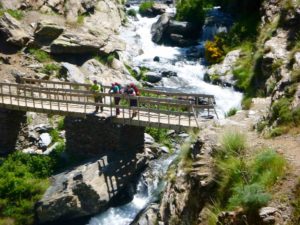
For the first three hours we follow the GR240 mainly downhill to the Cucaracha (Cockroach) Refuge. Now we take a traversing path past the Aceral Refuge to the Rio Real. We now join the “Estrella” path and follow the river downstream to cross the spectacular bridge over the Rio Guarnon.
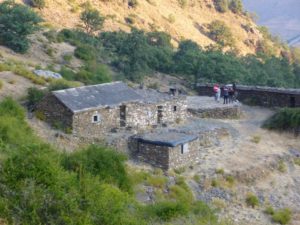 Now a final ascent begins to the Cortijos del Hornillo. Here there are several buildings and rooms that have sleeping platforms. Besides the larger of the buildings is an old threshing circle and just beyond that is a water supply. If this is not running you will have passed a small stream about 5 minutes before reaching Hornillo. Hornillo is a stunning situation to stay.
Now a final ascent begins to the Cortijos del Hornillo. Here there are several buildings and rooms that have sleeping platforms. Besides the larger of the buildings is an old threshing circle and just beyond that is a water supply. If this is not running you will have passed a small stream about 5 minutes before reaching Hornillo. Hornillo is a stunning situation to stay.
Day 5
The Cortijos del Hornillo to the University Albergue at Hoya de la Mora
A stunning day in the mountains. 5 to 6 hours.
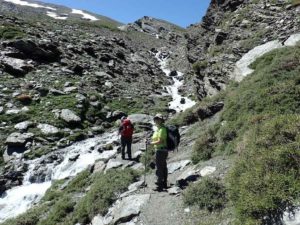
We start the day with a short climb to join a path that traverses around the mountainside and leads us around into the San Juan valley. We continue to contour around to where the river crosses the path. The best way on is to climb the steep east side of the stream until we gain the stunning alpine pastures above. Continue on sheep tracks northwards until you reach the path that leads across to the observatory and down to the University Albergue. Beers, showers and a nice restaurant!
Day 6
Hoya de la Mora to the Refugio Poqueira via Veleta (3394m)
Around 6 hours walking.
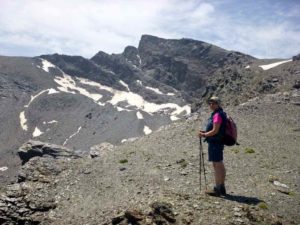 Not as hard as you might think! Veleta means “weather vane” and at 3394m is the 2nd highest mountain in the Sierra Nevada. Our prefered option is to take the National Park bus to 3000m before the ascent of Veleta. This gives us time to take little used paths up Veleta’s north West ridge. Veleta is an easy and popular mountain and the summit is usually busy, however the path we use means we rarely pass others until we reach the summit. Today we can expect to see Ibex, Alpine Accentors and Vultures.
Not as hard as you might think! Veleta means “weather vane” and at 3394m is the 2nd highest mountain in the Sierra Nevada. Our prefered option is to take the National Park bus to 3000m before the ascent of Veleta. This gives us time to take little used paths up Veleta’s north West ridge. Veleta is an easy and popular mountain and the summit is usually busy, however the path we use means we rarely pass others until we reach the summit. Today we can expect to see Ibex, Alpine Accentors and Vultures.
After Veleta we descend to the Carihuela Refuge (bothy), a good viewpoint and place to sit admiring the best views of both Mulhacén and Alcazaba (3371m and 3rd highest in the Sierra Nevada).
We now follow the old Sierra Nevada road for a short distance before descending the Rio Seco to spend the night in the Refugio Poqueira, a manned refuge with showers.
Day 7
A circuit on Mulhacén, 7 to 8 hours.
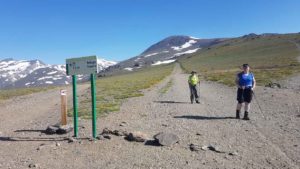 We choose to ascend Mulhacén by the “gentle” south ridge. Although this is a popular route and there will undoubtedly be others doing the same, it is a nice route offering plenty of sight seeing opportunities and some nice flowers in early summer. Our descent is via the west flank to the Caldera Refuge (bothy) with some fine views across the north face.
We choose to ascend Mulhacén by the “gentle” south ridge. Although this is a popular route and there will undoubtedly be others doing the same, it is a nice route offering plenty of sight seeing opportunities and some nice flowers in early summer. Our descent is via the west flank to the Caldera Refuge (bothy) with some fine views across the north face.
From the Caldera we take little used paths for about half of the descent back to the Refugio where we can celebrate our ascent of mainland Spain’s highest mountain.
Day 8
Refugio Poqueira to Capileira, 4 to 5 hours
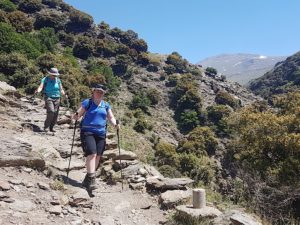 Initially a steep path down to the Cortijo las Tomas and a further descent into the delightful Rio Poqueira. The path undulates for a while and there are a couple of river crossings before our descent to the hydro electric plant and the deserted village of La Cebadilla. From here we follow the road and signposted paths back to Capileira.
Initially a steep path down to the Cortijo las Tomas and a further descent into the delightful Rio Poqueira. The path undulates for a while and there are a couple of river crossings before our descent to the hydro electric plant and the deserted village of La Cebadilla. From here we follow the road and signposted paths back to Capileira.
The Tour is now complete! There is no medal, no certificate, just the satisfaction of knowing you completed the Tour of Mulhacén.
Is this trip for me?
Most days we will be walking for around 7-8 hours on straight forward marked paths. You will need to carry a medium weight rucksack for the whole trip (we would recommend around 45 litres).
Mulhacén is 3482m and some paths cross the mountains at around 3000m. At this altitude you are likely to puff more, but should not feel any adverse affects.
We are offering the trek during August and September. You can reserve a place on the Tour of Mulhacén webpage or give us a call on 01433 639368 to talk through any questions you may have.





 Wild flowers are abundant in April, May and June with many varieties of orchid. The wild mountain goat or Iberian Ibex is especially common and will be seen throughout the year. Bird watchers will not be disappointed at any time of year. Especially common are Golden and Booted Eagles, Egyptian and Griffon Vultures, Bee Eaters and Crag Martins (and many more). Our Wildlife of the
Wild flowers are abundant in April, May and June with many varieties of orchid. The wild mountain goat or Iberian Ibex is especially common and will be seen throughout the year. Bird watchers will not be disappointed at any time of year. Especially common are Golden and Booted Eagles, Egyptian and Griffon Vultures, Bee Eaters and Crag Martins (and many more). Our Wildlife of the 




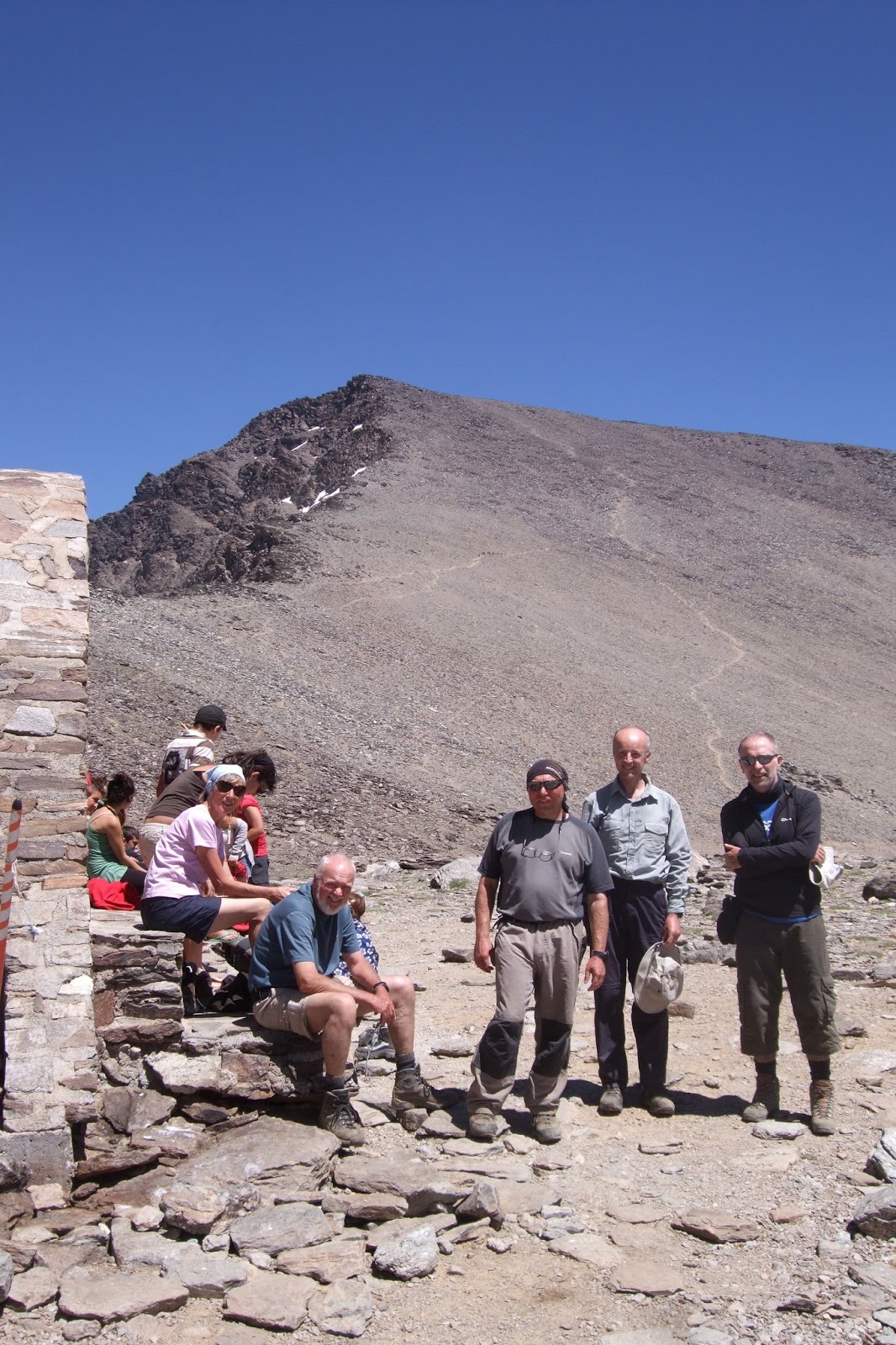
 Day 6 – Refugio Poqueira to Capileira
Day 6 – Refugio Poqueira to Capileira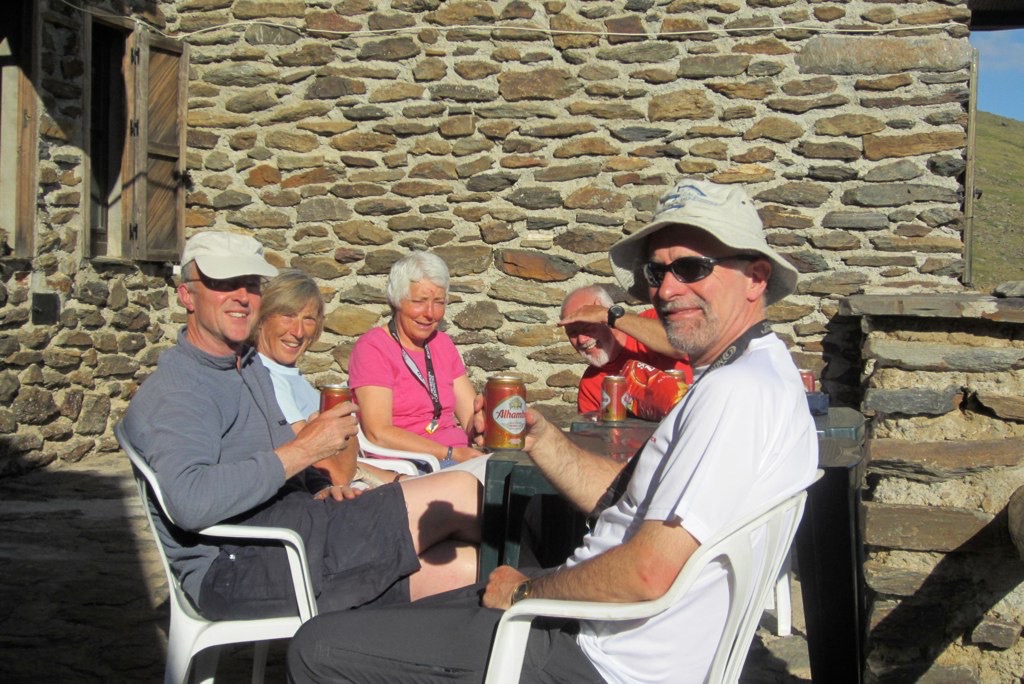
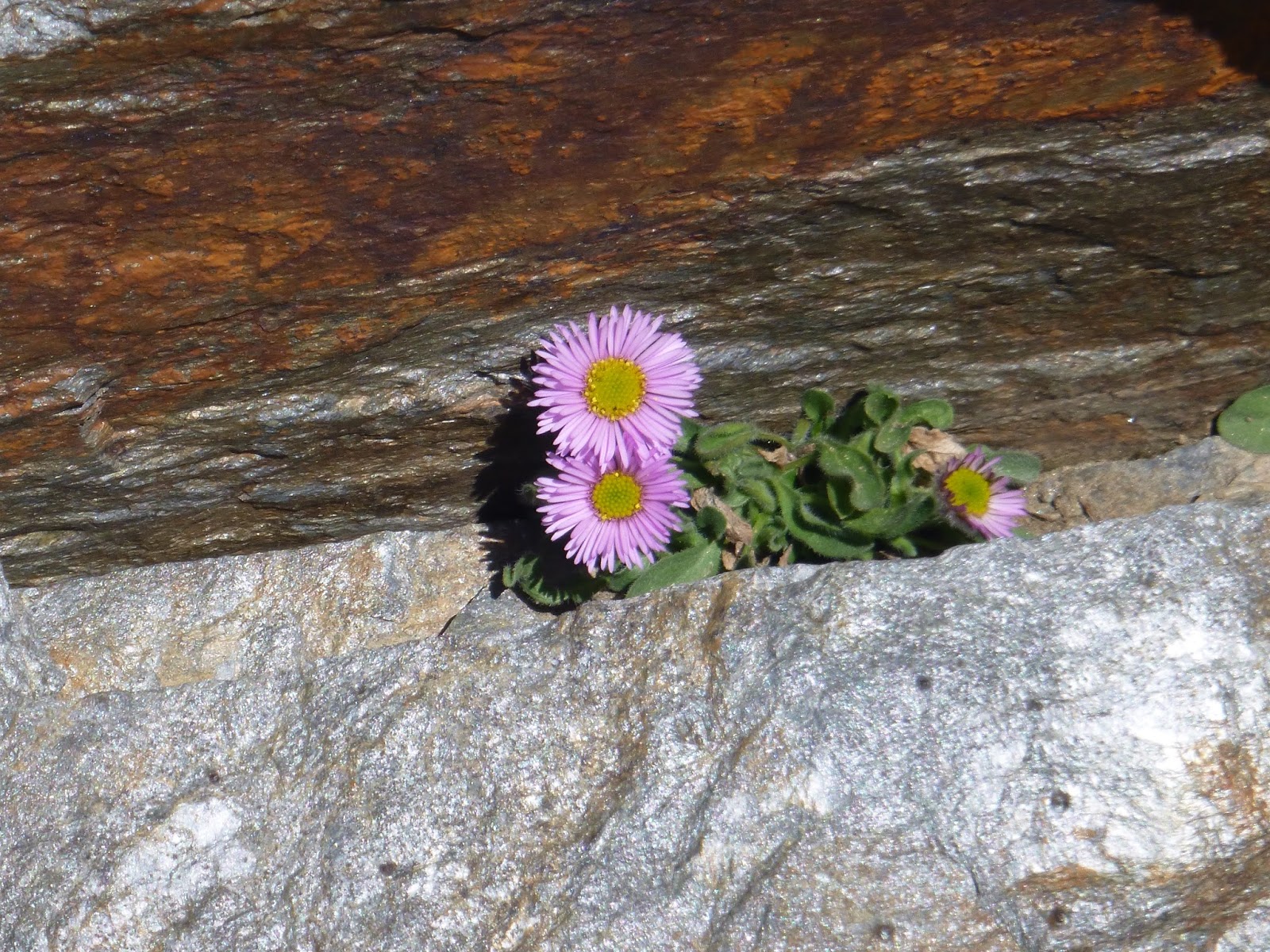


 rms and the Swallows and swifts are also back soaring above.
rms and the Swallows and swifts are also back soaring above.
